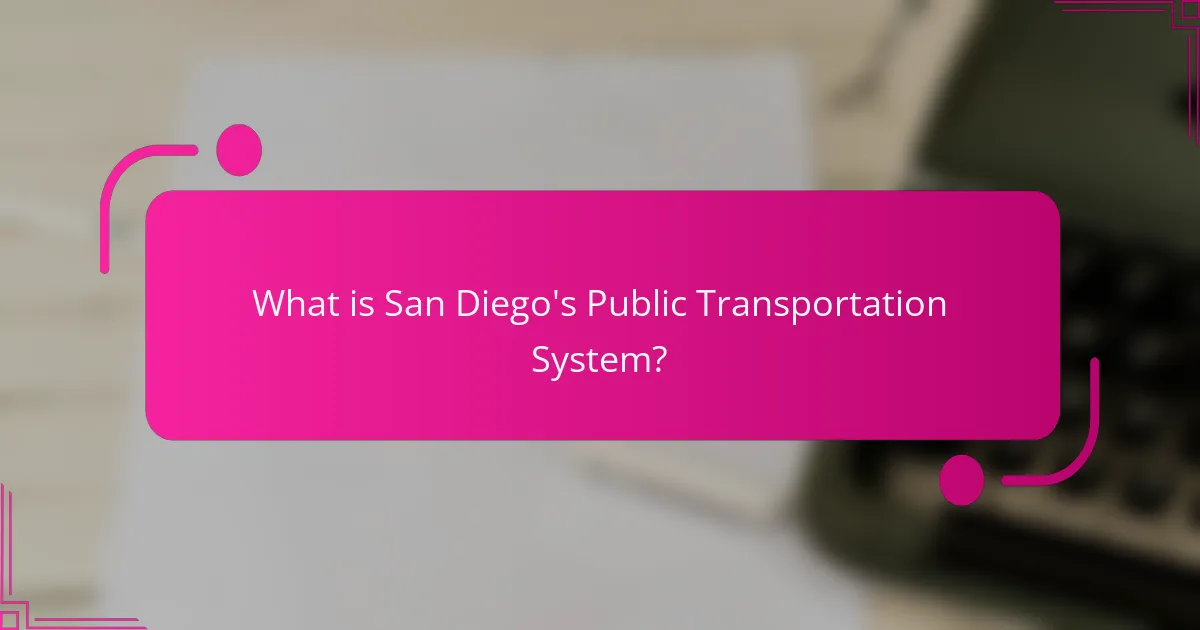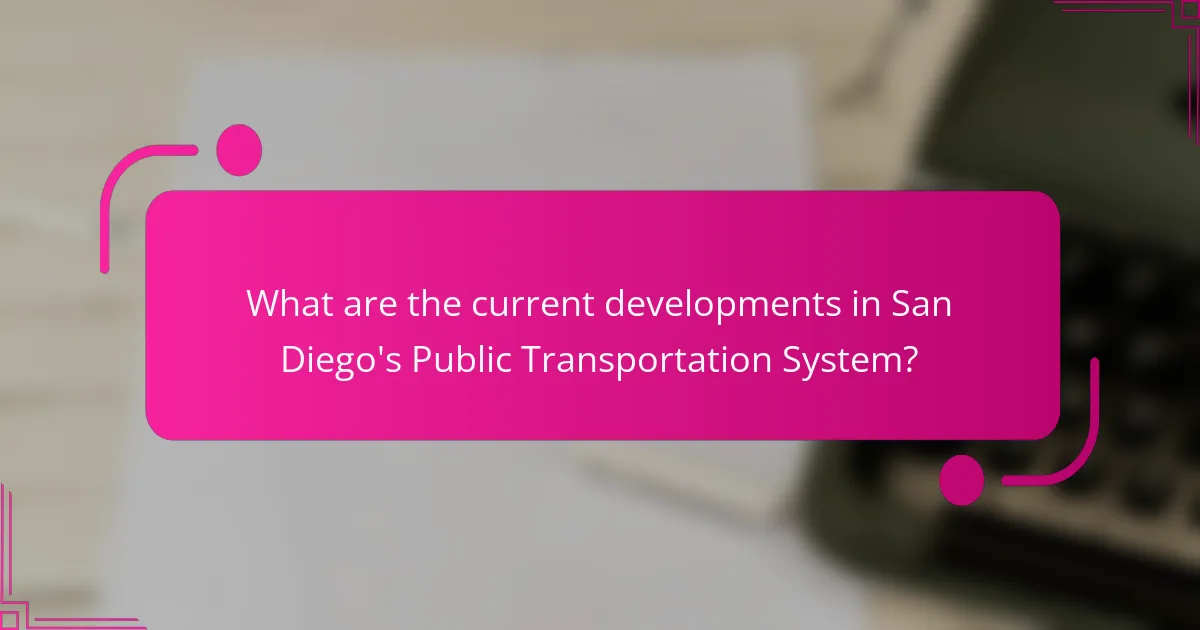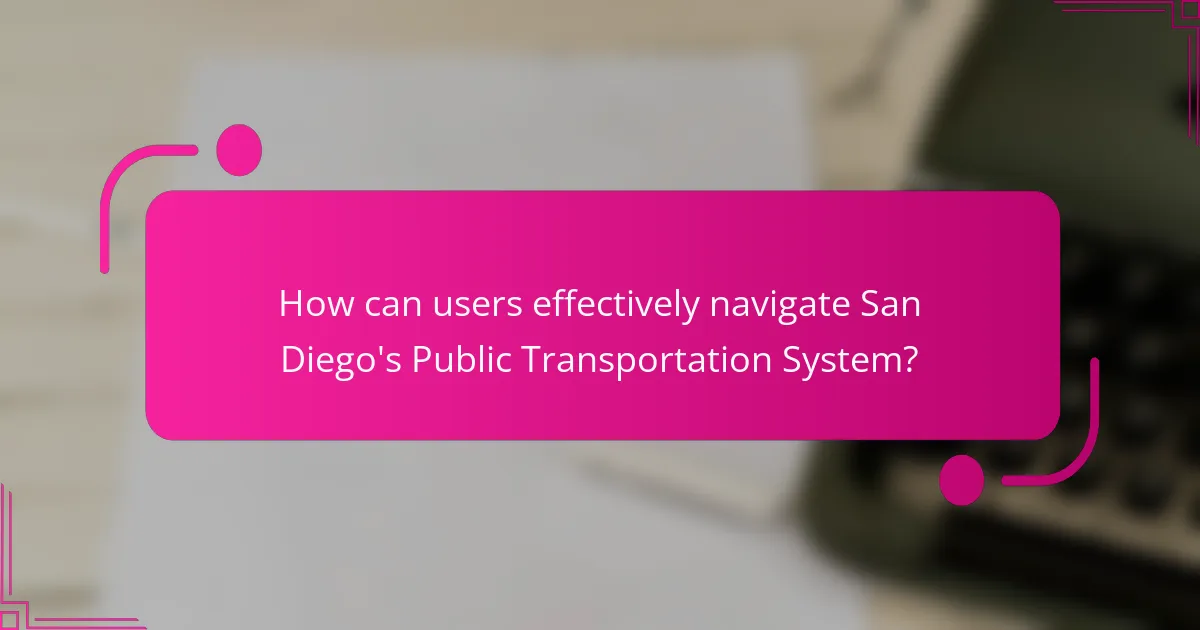
What is San Diego’s Public Transportation System?
San Diego’s Public Transportation System consists of buses, trolleys, and commuter trains. It is operated by the San Diego Metropolitan Transit System (MTS). The system serves over 90 million passengers annually. It covers a vast area with multiple routes across the city and surrounding regions. The trolley system has three lines: Blue, Orange, and Green. Buses provide extensive coverage, connecting neighborhoods and key destinations. Accessibility features include low-floor buses and trolleys for individuals with disabilities. The system aims to improve public transit options and reduce traffic congestion in the region.
How does San Diego’s Public Transportation System operate?
San Diego’s Public Transportation System operates through a network of buses, trolleys, and trains. The San Diego Metropolitan Transit System (MTS) manages these services. Buses serve various routes across the city and suburbs. Trolleys connect key areas, including downtown and the border. The Coaster train provides commuter service along the coastline. Schedules are available online and at transit stations. Fares can be paid via cash or transit passes. The system aims to provide accessible transportation for all residents. According to MTS, over 90,000 passengers use the system daily.
What are the main components of the transportation system?
The main components of the transportation system include infrastructure, vehicles, and operations. Infrastructure refers to the physical facilities like roads, bridges, and transit stations. Vehicles encompass buses, trains, and other modes of transport used for passenger and freight movement. Operations involve the management and coordination of transportation services. Each component plays a crucial role in ensuring efficient mobility. For example, San Diego’s public transportation relies on a network of buses and trolleys that connect various neighborhoods and destinations. This integrated approach enhances accessibility for residents and visitors alike.
How do different modes of transport integrate within the system?
Different modes of transport integrate within San Diego’s public transportation system through coordinated schedules and shared facilities. Buses, trolleys, and trains operate on overlapping routes to facilitate seamless transfers. Transit hubs, such as the Santa Fe Depot, serve as central points for multiple transport modes. Real-time information systems provide updates across all transport types, improving user experience. The Metropolitan Transit System (MTS) oversees the coordination of these modes. This integrated approach enhances accessibility and reduces travel times for commuters. Data from MTS indicates that over 90% of riders benefit from this connectivity.
What routes are available in San Diego’s Public Transportation System?
San Diego’s Public Transportation System offers several routes through buses and trolleys. The Metropolitan Transit System (MTS) operates these services. There are over 90 bus routes covering various neighborhoods and regions. The trolley system includes three lines: the Blue Line, the Orange Line, and the Green Line. These trolley lines connect major areas such as downtown, Mission Valley, and the border with Mexico. MTS routes provide access to key destinations like schools, shopping centers, and healthcare facilities. Additionally, routes are designed to facilitate transfers between bus and trolley services. The system operates daily, ensuring public transportation is available for commuters and visitors alike.
How are the routes designed to serve the community?
Routes are designed to serve the community by ensuring accessibility and connectivity. They are strategically planned based on population density and travel patterns. Community feedback is often incorporated into route design. Data from surveys and ridership statistics inform adjustments to meet local needs. Routes aim to connect residential areas with employment centers, schools, and healthcare facilities. The goal is to reduce travel time and improve convenience for users. Public meetings are held to gather input and enhance route effectiveness. Overall, the design process prioritizes community engagement and data-driven decision-making.
What are the most popular routes and why?
The most popular routes in San Diego’s public transportation system include the Blue Line, Orange Line, and Green Line. The Blue Line runs from the border to downtown and is favored for its accessibility to major attractions. The Orange Line connects East County to downtown, serving commuters and providing access to shopping areas. The Green Line connects Mission Valley to downtown, making it popular for its proximity to sports venues and universities. These routes are widely used due to their frequency, reliability, and connections to key destinations.
What role does accessibility play in San Diego’s Public Transportation System?
Accessibility is crucial in San Diego’s Public Transportation System. It ensures that all individuals, including those with disabilities, can use public transit. The San Diego Metropolitan Transit System (MTS) provides accessible buses and trolleys. These vehicles are equipped with features like low floors and ramps. Additionally, MTS offers paratransit services for those unable to use standard transit. Compliance with the Americans with Disabilities Act (ADA) mandates these accessibility measures. In 2020, MTS reported that over 90% of its bus fleet was accessible. This commitment enhances mobility and independence for all residents.
How is accessibility ensured for individuals with disabilities?
Accessibility for individuals with disabilities is ensured through various measures in San Diego’s public transportation system. The system includes features such as wheelchair-accessible vehicles and stations. Additionally, audio and visual announcements are provided for better navigation. Trained staff assist passengers with disabilities when needed. Compliance with the Americans with Disabilities Act (ADA) mandates these accessibility features. Regular assessments ensure that facilities meet evolving accessibility standards. Public feedback is also collected to identify areas for improvement. These efforts collectively enhance the overall experience for individuals with disabilities using public transportation in San Diego.
What are the challenges in making public transport accessible?
The challenges in making public transport accessible include physical barriers, inadequate infrastructure, and funding limitations. Physical barriers such as steps and narrow doorways hinder access for individuals with disabilities. Inadequate infrastructure, like insufficient ramps and elevators, complicates navigation. Funding limitations restrict the ability to implement necessary upgrades. Additionally, lack of awareness among operators can lead to insufficient training for staff. These factors collectively impede the goal of universal accessibility in public transport systems.

What are the current developments in San Diego’s Public Transportation System?
San Diego’s Public Transportation System is undergoing significant developments. The San Diego Association of Governments (SANDAG) is advancing the regional transit plan called the 5 Big Moves. This plan aims to enhance transit options through improved bus and rail services. A key project is the Mid-Coast Trolley extension, which will connect downtown San Diego to the University City area. Additionally, SANDAG is working on the development of a new transit-oriented development policy. This policy focuses on integrating housing with transit services. Furthermore, there is an emphasis on expanding electric bus fleets to promote sustainability. These developments are part of a broader effort to improve public transportation accessibility and efficiency in San Diego.
How is San Diego’s Public Transportation System evolving?
San Diego’s Public Transportation System is evolving through increased investment and modernization efforts. The San Diego Metropolitan Transit System (MTS) is expanding its services and routes. New trolley lines are being constructed to connect underserved areas. Additionally, the MTS is implementing electric buses to reduce emissions. The introduction of real-time tracking apps enhances user experience. Recent funding from federal and state sources supports these initiatives. In 2022, a $300 million federal grant was awarded for transit improvements. These changes aim to make public transportation more accessible and efficient for residents and visitors.
What new technologies are being implemented?
San Diego’s public transportation system is implementing several new technologies. These include real-time tracking systems for buses and trolleys. Passengers can access live updates through mobile apps. Contactless payment systems are also being introduced for easier fare collection. Additionally, electric and hybrid vehicles are being integrated into the fleet. These vehicles aim to reduce emissions and improve sustainability. Smart traffic signals are being tested to enhance traffic flow. Overall, these technologies aim to improve efficiency and user experience in public transportation.
How are community needs influencing current developments?
Community needs are significantly influencing current developments in San Diego’s public transportation system. Increased demand for accessible transit options is driving investments in infrastructure. Community feedback has led to the expansion of routes to underserved areas. Local advocacy groups are pushing for environmentally sustainable solutions. Data from the San Diego Association of Governments shows rising ridership numbers. This data highlights the necessity for improved services. Additionally, public forums have indicated a desire for enhanced safety measures. These needs are shaping the planning and execution of future transportation projects.
What future plans exist for San Diego’s Public Transportation System?
San Diego’s Public Transportation System plans to expand and enhance its services in the coming years. The San Diego Association of Governments (SANDAG) has proposed a comprehensive plan called the 2021 Regional Plan. This plan includes the development of new transit lines and improvements to existing routes. Specific projects involve the extension of the Blue Line Trolley and the addition of a new Bus Rapid Transit (BRT) line.
Funding for these initiatives is expected from state and federal grants, as well as local sales tax measures. SANDAG aims to increase ridership by making public transit more accessible and efficient. The goal is to reduce traffic congestion and promote sustainable transportation options. These developments align with the city’s commitment to environmental sustainability and urban mobility.
How will expansion projects affect existing routes?
Expansion projects will enhance existing routes by increasing capacity and improving connectivity. These projects often involve adding new lines or stations. As a result, travel times may decrease for commuters. Additionally, expansion can lead to more frequent service on existing routes. This improvement is supported by increased funding and planning efforts from local authorities. For instance, the San Diego Association of Governments (SANDAG) has outlined specific expansions in their regional transportation plan. Such developments aim to accommodate growing populations and reduce traffic congestion. Ultimately, these expansions contribute to a more efficient public transportation system.
What are the expected benefits of future developments?
Future developments in San Diego’s public transportation system are expected to enhance efficiency and accessibility. Improved routes will reduce travel time for commuters. Increased service frequency will provide more options for riders. Enhanced accessibility features will accommodate individuals with disabilities. Development of dedicated transit lanes will alleviate congestion. Integration of technology will offer real-time updates to passengers. Expanded service areas will connect underserved neighborhoods. Sustainable practices will reduce environmental impact. These benefits collectively aim to create a more user-friendly and efficient public transportation experience in San Diego.

How can users effectively navigate San Diego’s Public Transportation System?
Users can effectively navigate San Diego’s Public Transportation System by utilizing the San Diego Metropolitan Transit System (MTS) resources. The MTS provides a comprehensive website and mobile app that offer real-time schedules and routes. Users can access maps and plan trips based on their starting point and destination. The system includes buses and trolleys, with clear signage at stops to indicate routes. Additionally, users can purchase tickets online or at vending machines located at trolley stations. The MTS also offers accessibility features for individuals with disabilities. According to the MTS, over 90% of the city’s residents live within a quarter-mile of a transit stop, making it convenient for most users.
What tips can help users maximize their experience with public transport?
To maximize the experience with public transport, users should plan their routes in advance. Familiarizing oneself with schedules and maps can reduce wait times. Utilizing real-time tracking apps enhances efficiency. Users should also consider off-peak travel times to avoid crowds. Having exact change or a transit pass can streamline fare payment. Staying aware of safety protocols ensures a secure journey. Engaging with customer service can resolve issues promptly. Lastly, being respectful to fellow passengers contributes to a pleasant environment.
How can users plan their trips efficiently?
Users can plan their trips efficiently by utilizing San Diego’s public transportation system. They should start by identifying their destination and preferred mode of transport. The Metropolitan Transit System (MTS) provides a comprehensive route map and schedule online. Users can access real-time information through the MTS app or website. Planning ahead allows users to choose the best times for travel to avoid peak hours. Additionally, understanding the fare structure helps in budgeting for the trip. Users can also consider multi-modal options, such as combining buses and trolleys for convenience. Checking for any service alerts or changes in schedules is essential for smooth travel.
What resources are available for real-time updates and information?
Real-time updates and information for San Diego’s public transportation system are available through various resources. The San Diego Metropolitan Transit System (MTS) provides a mobile app for users to access live bus and trolley schedules. Additionally, the MTS website offers real-time tracking and service alerts. Social media platforms like Twitter and Facebook also share timely updates on service changes. Furthermore, local news outlets often report on significant transit developments. These resources ensure that riders have access to current information regarding routes and schedules.
What common challenges do users face, and how can they be addressed?
Users of San Diego’s public transportation system commonly face challenges such as limited route options, infrequent service, and accessibility issues. Limited route options restrict users’ ability to reach desired destinations efficiently. Infrequent service leads to longer wait times, discouraging public transport use. Accessibility issues affect individuals with disabilities, making it difficult for them to utilize the system.
To address these challenges, expanding route coverage can provide better access to key areas. Increasing the frequency of service during peak hours can reduce wait times and improve user satisfaction. Implementing more comprehensive accessibility features, such as ramps and audio announcements, can enhance the experience for users with disabilities.
Research shows that cities with improved public transportation systems see increased ridership and user satisfaction. For example, a study by the American Public Transportation Association found that enhancing service frequency can lead to a 10-20% increase in ridership.
How can users troubleshoot issues with routes or schedules?
Users can troubleshoot issues with routes or schedules by checking the official transit website or app for real-time updates. These platforms provide information on delays, detours, and service changes. Users can also contact customer service for assistance with specific route inquiries. Additionally, consulting social media channels may offer community-driven updates. Observing posted schedules at transit stops can clarify timing discrepancies. If issues persist, users should report them to the transit authority for resolution.
What support services are available for users in need of assistance?
San Diego’s public transportation system offers various support services for users in need of assistance. These include paratransit services for individuals with disabilities, which provide door-to-door transportation. The Metropolitan Transit System (MTS) also offers travel training programs to help users navigate the transit system. Additionally, there are customer service representatives available to assist with route planning and fare information. MTS provides accessible vehicles equipped with features for individuals with mobility challenges. The system also includes information resources, such as websites and helplines, to answer questions and provide guidance. These services ensure that all users can access public transportation effectively and safely.
San Diego’s Public Transportation System, managed by the San Diego Metropolitan Transit System (MTS), encompasses buses, trolleys, and commuter trains, serving over 90 million passengers annually. The system features extensive routes, including the Blue, Orange, and Green trolley lines, and emphasizes accessibility for individuals with disabilities. Current developments aim to enhance transit options and sustainability through projects like the Mid-Coast Trolley extension and the introduction of electric buses. Users can effectively navigate the system using real-time tracking resources and by planning their trips based on available schedules and routes.